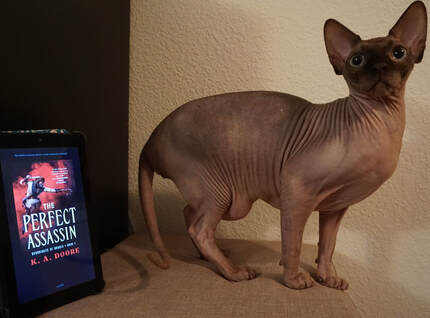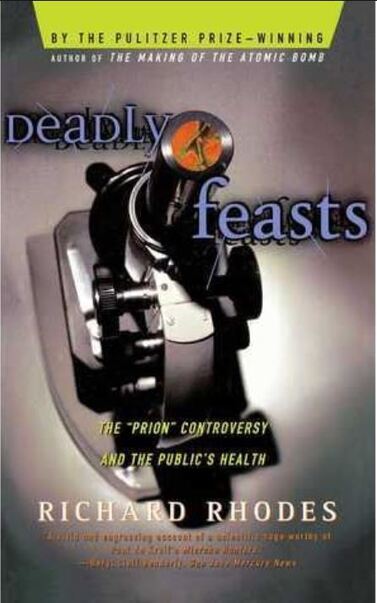|
One of my cats, Clouseau, poses with the e-book cover. He likes to consider himself an assassin of bugs. Photo by Kate Ota 2020 When I finished The Perfect Assassin by K.A. Doore, I didn’t want it to end. (Lucky for me, there’s more books in this series!) This was an excellent adult secondary world fantasy. The lead character, Amastan, finishes his assassin lessons in the desert city of Ghadid, only to discover a dead body. He needs to solve the case or risk the assassins being blamed and expelled from the city. Not a typical plot expected from the title, it was what I’d call fantasy noir.
This world also features a touch of magic, and souls of the dead left un-tended turn into wild spirits that drive people insane. There’s some water magic as well, with healing properties reminiscent of Avatar the Last Airbender. The made-up words were sprinkled throughout with plenty of context, and all added to the flavor of the setting. Positives: Some of the best world building I’ve read in a while. A secondary world can sometimes be an uphill battle against a lot of unfamiliar terms, but this was done extremely well. Plot was interesting and kept me reading, and Amastan was a very sympathetic lead. Negatives: None. Fight me. Overall rating: 5/5 I’d recommend to anyone who loves fantasy, especially if they’re not looking for a major romance subplot. (There’s a romance, but it’s not at the forefront, and it’s sweet instead of hot and heavy.) If you’re writing a secondary world fantasy or another genre with lots of made-up terminology, I recommend this as a book to study. The balance of words, how they’re spread out, the way they are embedded in context, are all on point. Not for people who are looking for typical high fantasy, because while this is another world and has a little magic, it isn’t a sorcerer-and-dragon book. However, these people might come around eventually and enjoy it too. Everyone just give it a chance. Have you read The Perfect Assassin? Let's discuss in the comments!
0 Comments
A lovely waterfall in Rocky Mountain National Park. Remember when we could go outside and be with people and nature? Good times. Photo taken by Kate Ota 2011 As the global quarantine continues, I still hear from other writers that they can’t make themselves write. Everyone handles stress differently, and creativity shutting down is a common one. I wrote a post a few weeks ago about writing without inspiration, but if that doesn’t help, I’ve come up with ideas for how to improve your craft without writing. It’s not as good as writing, but it’s better than binging another Netflix show. (Except Nailed It! Love that one.)
1. Read a Craft Book It could be a book about plotting, like Save The Cat Writes a Novel by Jessica Brody. Or maybe you want a general writing guide, like Elements of Style by Strunk and White. Consider what feedback you’ve gotten from critique partners or alpha and beta readers and find a book to focus on your stories’ weakest aspects. Characterization, showing not telling, deep POV, connecting to readers, finding your unique voice, there’s craft books for every occasion. I recommend buying a physical copy (from your local indie bookstore who may be struggling right now!) so that you can mark it up. Highlighter, flags, notes in the margins, the works. Read, absorb, annotate, learn, and improve your craft without forcing yourself to a keyboard. 2. Listen to Writing Podcasts There are dozens of writing podcasts to choose from. There are those that focus on craft, like Writing Excuses, The Manuscript Academy, and Lit Service, to name a few of my favorites. These are often run by authors and feature literary agents or editors. Some are run totally by agents like Shipping and Handling, Print Run Podcast, KT Literary Podcast, and Literaticast. These cover the gambit from queries to writing advice to publishing-world news. Not to mention there are thousands of other podcasts and if your novel focuses on or features something you need to research, I guarantee there’s an episode (maybe a whole show!) about it. If you want to feel more social, there are also book club podcasts, like the one I contribute to: Judging More Than Just the Cover: Book Club. (We took a hiatus but we just recorded a new episode!) Podcasts are great to listen to around your house as you clean, exercise, or stare at the ceiling wondering if you have COVID-19 or just allergies. 3. Create a Style Sheet This is something I heard an editor talk about recently on a podcast. (Don’t ask me which one, I’ve listened to way too many.) She said editors make a style sheet that lists rules for the story with the goal of making sure it’s consistent. How names or made up words are spelled, the timeline of the novel (including times, days, seasons, etc.), the physical space the characters travel (and how long it takes to get from place to place), and character voices. The voices were the most intriguing part to me. There are rules for which character gets to say what and how, so their dialogue/internal narration doesn’t all sound like the same person (which it is because it’s the author, but you don’t want the reader to notice.) Writing Excuses Podcast suggested looking at varying character voice by altering the pacing (punctuation), accent (sentence structure and word choice), and attitude (how they feel/deliver the line and word choice again.) With this sheet in place, it will be easier to edit your story for character consistency, spelling consistency, and space/time logic. Your future self, whenever that self gets back to writing, will thank you! 4. Read Your Genre Ever struggled to come up with comp titles while querying? Now is the time to read books you suspect could be similar to yours, but you haven’t had time to read. If you’re struggling with ideas, ask your writing group, alpha or beta readers, or family what book your writing brings to mind. It could be based on plot elements, style, humor, or a similar audience. Really stuck? People ask for book recommendations on Twitter and get tons of responses, but make sure to be specific (e.g. rather than asking for sci-fi, ask for sci-fi set in a near future dystopia with a female MC.) You can always Google it, but be aware it may result in a lot of inaccurate matches. In normal times I would recommend asking your librarian or book seller. To adapt, maybe use email (if they offer it) or ask by tagging them on social media. Even if you don’t get a proper comp title out of the books you read, you’ll still become even more familiar with your genre, maybe discover a new author you like, or read a great new twist on a trope. It’s a win-win activity. Have you discovered a way of improving your writing without writing? Or maybe you’ve discovered another way to pass time during the shut-down? Let’s discuss in the comments! Cover of Deadly Feasts as seen on Goodreads. In my ebook it was a plain white background! I recently finished Deadly Feasts by Richard Rhodes, a non-fiction book focused on the discovery and study of prion diseases. It was an interesting look at how diseases are studied in general, and how these diseases seem to break rules and make studying them into decades-long endeavors. It starts with kuru, a disease of the South Forte people of Papua New Guinea linked to a tradition of eating deceased relatives. (The tradition ended when the disease origin was explained to them.) Other famous prion diseases include mad cow disease (aka bovine spongiform encephalopathy), scrapie (in sheep), and Creutzfeldt-Jacob Disease (aka CJD or vCJD, which got a shout-out on the season 16 finale of Grey’s Anatomy.) All of these are diseases in which the victim could be incubating the problem for years—even decades—before symptoms show. All of them attack the brain, causing coordination or balance issues, mental decline, and then death. We have no cure for any prion disease at this time.
Positives: This book fascinated me. The mystery of what caused the diseases was compelling, even though I’d already heard of prions. When it was published (in 1997) prions were still controversial. An author’s note in my version even stated that Richard Rhodes suspected prions weren’t just protein, however now it’s more widely accepted. The book was very well written and organized with a huge amount of information crafted into an easy to understand story. Negatives: Reading this in the midst of the COVID-19 pandemic was probably not a great choice. The book predicted a second wave of CJD epidemic in the UK (due to food tainted with mad cow disease eaten in the 80’s and 90’s, the first wave occurred in the late 90’s) and that epidemic would be in 2015. Aren’t we glad that didn’t happen? Although it probably means it’s still coming. Luckily, it’s far less contagious than a respiratory virus (thank goodness!), but it’s sadly more deadly. And those in medicine still need to remain vigilant, as a cornea transplant, dura mater transplants, blood transfusions, and possibly contaminated dental/surgical tools have transmitted CJD or vCJD. Terrifying! Overall rating: 4/5 A great read for anyone interested in medicine, epidemiology, medical mysteries, scientific mysteries, or pandemics. It’s written at a level understood by anyone with an 8th grade or higher science background, so no one should feel intimidated to read it. The author won a Pulitzer Prize for a previous book, and the quality of the writing shows. I don’t recommend for anyone with hypochondria or severe health-anxiety, especially in the current pandemic. Have you read Deadly Feasts? What did you think? The classic inspiration, a sunset. A beach in Massachusetts. Photo by Kate Ota 2019 This pandemic is getting people down. Sure, some are working hard on their #CampNaNoWriMo projects (and more power to you!) but others are struggling to write a single word. While many have more time at home than usual, some are trying to juggle working from home and teaching kids with writing, or are essential and working outside the home more than before. I’ve seen many on twitter claiming the muse isn’t appearing or they just can’t force themselves to a keyboard. I found myself in the latter group, but have done a few writing exercises that helped me get back into my #WIP. Here are my ideas to help you ease in to writing even when you’re not inspired.
1. Fill the gaps in your world-building For off-world adventures, have you thought about the animals, birds, and insects of your world? For our-world stories, have you fleshed out the side characters? Maybe there’s something you let drop off to the side earlier in the draft and you said, “I’ll figure that out later.” Now’s the time to think about your novel’s world and make sure it’s full. Even if most of what you create here never makes it to the page, you need to know how things run. This can get your mind focused on your project again, and thinking of filling holes may lead you to go in and fill them. 2. Write a commercial for a product in your WIP This was fun for me, since my current WIP’s plot is all about a business. But every writing project, even one without a business explicitly part of the plot, could have a commercial. Radio, print ads, or even the town crier apply, for historical settings. It gives you a sense of what people in your world value, or explain something the character has in their home. A particular weird flavor of toothpaste the MC loves, the bistro where a grisly murder took place, a hotel where the two lovers meet for their hook up. It’s a goofy thing that can get you thinking about your characters and their world. 3. Research a relevant topic Maybe it’s as complicated as how a toxin works, or how a space station would function. Maybe it’s as simple as watching your MC’s favorite movie. Whatever it is, there’s something you know you need to research a little more to ground the setting, round out a character, or carry a plot point. Once you do your research, you’ll write it down so as to not forget it, and maybe even figure out where to use it in your WIP. 4. Write a scene you don’t plan to use Maybe it’s a technical explanation of how the murder victim died. Or it’s a fight between the MC’s parents. Write anything taking place in your world, regardless of relevance to your MC or the main plot. Maybe it’ll spark something in you, maybe it won’t. But it’ll get you started writing, and that’s the hardest part. Sitting down and getting the juices flowing is essential to writing. Always challenge, but more so with the anxiety of our current world. Hopefully these ideas helped you get started again. Do you have any other tips for getting back to your writing? Let’s discuss in the comments! |
Archives
February 2024
Categories
All
|





 RSS Feed
RSS Feed